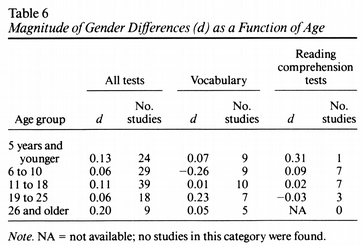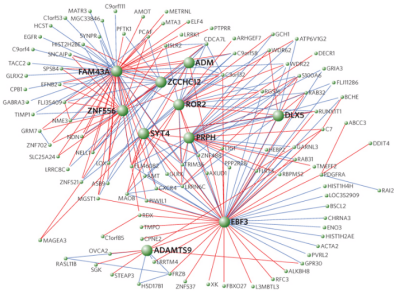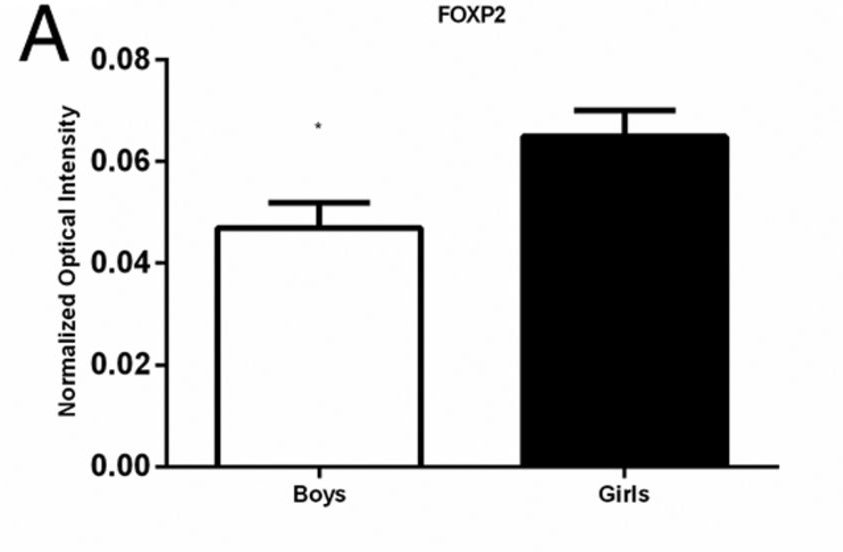Sex and FOXP2: Preservation of endangered stereotypes
« previous post | next post »
Last week, when I discussed the return of the zombie meme about women talking three times more than men ("An invented statistic returns", 2/22/2013), I promised to come back to the real scientific results in the paper whose public relations campaign unleased that extraordinary outburst of mass-media pseudoscience.
The paper was J. Michael Bowers, Miguel Perez-Pouchoulen, N. Shalon Edwards, and Margaret M. McCarthy, "Foxp2 Mediates Sex Differences in Ultrasonic Vocalization by Rat Pups and Directs Order of Maternal Retrieval", The Journal of Neuroscience, February 20, 2013, As the title indicates, the paper is mostly about baby rats; and the reader is hereby warned that the following discussion may be longer than you're going to be willing to sit through. I'm afraid, though, that if you care about what this paper said and what it means, you're going to have to put in some time, here or elsewhere.
First, a bit of background about Foxp2. As Wikipedia explains,
Forkhead box protein P2 also known as Foxp2 is a protein that in humans is encoded by the FOXP2 gene, located on human chromosome 7 (7q31, at the SPCH1 locus). Foxp2 orthologs have also been identified in all mammals for which complete genome data are available. The Foxp2 protein contains a forkhead-box DNA-binding domain, making it a member of the FOX group of transcription factors, involved in regulation of gene expression.
Like all genes, FOXP2 interacts with many other genes, along with epigenetic and environmental factors, to create, maintain and regulate all sorts of structures and functions. From Genevieve Konopka et al., "Human-specific transcriptional regulation of CNS development genes by FOXP2", Nature 462: 213-217, 11/12/2009, here's a picture of "one of the modules containing FOXP2 and FOXP2chimp differentially expressed genes":
And let me quote again from the scientist who first identified the role of the FOXP2 gene in speech and language impairment, Simon Fisher, ("Tangled webs: Tracing the connections between genes and cognition", Cognition 101(2): 270-297, September 2006.):
[T]he deceptive simplicity of finding correlations between genetic and phenotypic variation has led to a common misconception that there exist straightforward linear relationships between specific genes and particular behavioural and/or cognitive outputs. The problem is exacerbated by the adoption of an abstract view of the nature of the gene, without consideration of molecular, developmental or ontogenetic frameworks. […] [A]doption of an abstract concept of the gene can lead to erroneous conclusions, which are incompatible with current knowledge of molecular and developmental systems. Genes do not specify behaviours or cognitive processes; they make regulatory factors, signalling molecules, receptors, enzymes, and so on, that interact in highly complex networks, modulated by environmental influences, in order to build and maintain the brain.
The FOXP2 mutation that Fisher et al. identified in the KE family ("Localisation of a gene implicated in a severe speech and language disorder", Nature Genetics, 1998) was associated with "an underlying impairment in coordination of the orofacial musculature affecting non-speech movements", as well as speech apraxia, higher-level language problems, and general cognitive issues. And to emphasize again that FOXP2 is not "the language gene" or "the speech gene" or even "the vocalization gene", we can learn from Weiguo Shu et al. ("Foxp2 and Foxp1 cooperatively regulate lung and esophagus development", Development 2007) that:
The airways of the lung develop through a reiterative process of branching morphogenesis that gives rise to the intricate and extensive surface area required for postnatal respiration. The forkhead transcription factors Foxp2 and Foxp1 are expressed in multiple foregut-derived tissues including the lung and intestine. […] [L]oss of Foxp2 in mouse leads to defective postnatal lung alveolarization, contributing to postnatal lethality. […] These data identify Foxp2 and Foxp1 as crucial regulators of lung and esophageal development, underscoring the necessity of these transcription factors in the development of anterior foregut-derived tissues and demonstrating functional cooperativity between members of the Foxp1/2/4 family in tissues where they are co-expressed.
OK, against this background, what did Bowers et al. find? From their abstract:
We observed that isolated male rat pups emitted substantially more USV [ultrasonic vocalization] calls and these were characterized by a significantly lower frequency and amplitude compared with female rat pups. Moreover, the dam was more likely to first retrieve male pups back to the nest, then females. The amount of Foxp2 protein was significantly higher in multiple regions of the developing male brain compared with females and a reduction of brain Foxp2 by siRNA eliminated the sex differences in USVs and altered the order of pup retrieval. Our results implicate Foxp2 as a component of the neurobiological basis of sex differences in vocal communication in mammals.
After reading the paper, I remain puzzled about the time scale on which the FOXP2 gene and its associated protein affect the vocalization of rat pups, and therefore about the presumed mechanisms of influence. Do different levels of Foxp2 protein in the brains of rat pups directly influence their vocalizations at the time of testing, say by modulating neurotransmitter levels? Or rather, do different levels of Foxp2 shortly after birth cause developmental changes (say in neural cytoarchitecture), which then later affect vocalizations?
Some hints in the paper suggest that they have the second sort of thing in mind. Thus they cite a 2010 paper about zebra finches showing that "chronic reduction of Foxp2 expression with viral transfection of siRNA directed against the mRNA reduces dendritic spines on striatal neurons". And in their experiment, the intracerebroventricular injections of Foxp2 siRNA (or the scrambled missense control dose) were done on the first two days of life ("ICV injections were done on PN0 and PN1"), whereas the isolation-call experiments were done on the fourth day of life ("Vocal emissions were recorded for 5 min using PN4 pups that were isolated from maternal interaction").
Some rat biochemists among our readers may be able to clarify this one way or the other, but I interpret this to mean that the siRNA suppression of Foxp2 expression would probably have influenced the rats' behavior mainly through differences in brain development over the intervening three days, and not through some physiological effect mediated more directly by Foxp2 levels at the time of testing. There is a discussion (e.g. in respect to their Fig. 3) of the time-course of the Foxp2 supression, but I don't understand its implications for interpretation of the main results.
The observed behavioral efffect was this:
Control males produced 603 total vocalizations compared with the 350 produced by control females (Fig. 2A, post hoc, p values <0.001). In contrast, siRNA-treated males produced 466 total vocalizations, which were significantly fewer than control males (post hoc, p < 0.05). Moreover, siRNA-treated females produced 465 total vocalizations, which was significantly more than the control females (post hoc, p < 0.05). The observed reversed pattern for siRNA-treated females to produce more total vocalizations and for the siRNA-treated males to produce fewer total vocalizations was not a hypothesized outcome.
There' are some previous pubications on manipulations of FOXP2 in mice, whose results and interpretations are complex and not entirely congruent with these results in rats — there's a fairly extensive discussion in "Mice with the 'Language Gene' stay mum", 6/4/2009.
Now, what about humans?
Fresh-frozen human cortex samples from boys and girls were obtained from the University of Maryland Brain and Tissue Bank. Demographics on the male tissue samples are as follows: 5 males, all of whom were Caucasian. The postmortem interval range was 15–19 h and the mean age was 4 years 196 d, with an age range of 4 years 5 d to 5 years 114 d. For the female tissue samples there were 5 females: 1 Caucasian, 3 African American, and 1 Asian. The postmortem interval range was 12–24 h and the mean age was 4 years 268 d, with an age range of 3 years 347 d to 5 years 34 d. All donor tissue was free of disease or infection. In all cases, the cause of death was due to accident. The cortex samples were all from the left hemisphere and taken from Brodmann's area 44.
Let me note in passing that the low N (five boys and five girls) makes it possible, and even likely, that there were some confounding factors other than sex — indeed, the paper cites one, namely race.
Anyhow, here are the results:
And here's their description of the results:
Because normal functioning FOXP2 is important for human language, we obtained human cortex samples from non-diseased donors. The cortex samples were all from the left hemisphere, specifically Brodmann's area 44. We found females to have higher basal levels of FOXP2 protein than males, (t(8) = 2.54, p = 0.03, Fig. 5A). There was no gender difference in the amount of protein levels for the closely related FOXP1 (t(8) = 1.86, p = 0.1, Fig. 5B).
Based on measuring the graphs (the paper doesn't give the numbers), it seems that the proportional difference in means is actually bigger for Foxp1 than for Foxp2 (about 1.5 to 1 vs. 1.4 to 1), so that when they write that "There was no gender difference in the amount of protein levels for the closely related FOXP1", we could alternatively read that as "In this sample, the variance of Foxp1 in girls was greater (because of one outlier?), and as a result, the difference in means (though in the same direction as for Foxp1) did not quite achieve statistical significance".
But more important, if we take Bowers et al.'s interpretation of their human results at face value, we might interpret it in relation to one plausible interpretation of the literature on human language development, namely that female infants and toddlers do have an average advantage over boys in various aspects of speech and language development, with the difference generally decreasing or even swinging the other way though primary- and secondary-school years. See e.g. this table from Janet Shibley Hyde and Marcia C. Linn, "Gender Differences in Verbal Ability: A Meta-Analysis", Psychological Bulletin 1988. Positive d means an an average advantage for females (expressed as difference in group means divided by within-group standard deviation); negative d means an average advantage for males.

There seem to be somewhat larger sex differences in vocabulary size for younger infants (e.g. this study of 18- and 24-month-old infants), though I haven't found a meta-analytic survey that breaks the effects down by age. But see Janet Shibley Hyde, "The Gender Similarities Hypothesis", American Psychologist 2005, for a broader and more recent meta-analysis of behavioral meta-analyses; and Mikkel Wallentin, "Putative sex differences in verbal abilities and language cortex: A critical review", Brain and Language, 2009, for a review of both behavioral and neurological evidence.
This interpretation of Bowers et al.'s human results is a bit of a stretch, since their human sample was so small and so problematic in other ways. But even if we accept this interpretation for the sake of argument, it's a long way from Foxp2 levels in the developing brains of kids between 3 and 5 years old, to these random interpretations from the extensive press coverage:
Scientists have discovered that women possess higher levels of a "language protein" in their brains, which could explain why females are so talkative.
Women’s brains have higher levels of a “language protein” called FOXP2, according to a study conducted by researchers at the University of Maryland School of Medicine.
Does your guy nag you for talking too much? Shut him down next time by letting him know that women gab more because of…our superior brain activity.
The study, compiled by neuroscientists and psychologist from the University of Maryland, concluded that women talked more because they had more of the Foxp2 protein.
Researchers at the University of Maryland School of Medicine found a chemical called 'Foxp2′ was responsible for the fact the average women speaks 20,000 words a day, 13,000 more than the average man.
See "An invented statistic returns" (2/22/2013) for a larger and more depressing sample.
My conclusions?
- Sex (difference) sells.
- Validation of endangered stereotypes sells even better.
Here's a small test of these hypotheses. Among the many interesting and important papers about the relationship between FOXP2 and human language, one of my favorites is Sonjua C. Vernes et al., "A Functional Genetic Link between Distinct Developmental Language Disorders", The New England Journal of Medicine, November 2008. Its abstract:
BACKGROUND: Rare mutations affecting the FOXP2 transcription factor cause a monogenic speech and language disorder. We hypothesized that neural pathways downstream of FOXP2 influence more common phenotypes, such as specific language impairment.
METHODS: We performed genomic screening for regions bound by FOXP2 using chromatin immunoprecipitation, which led us to focus on one particular gene that was a strong candidate for involvement in language impairments. We then tested for associations between single-nucleotide polymorphisms (SNPs) in this gene and language deficits in a well-characterized set of 184 families affected with specific language impairment.
RESULTS: We found that FOXP2 binds to and dramatically down-regulates CNTNAP2, a gene that encodes a neurexin and is expressed in the developing human cortex. On analyzing CNTNAP2 polymorphisms in children with typical specific language impairment, we detected significant quantitative associations with nonsense-word repetition, a heritable behavioral marker of this disorder (peak association, P=5.0×10−5 at SNP rs17236239). Intriguingly, this region coincides with one associated with language delays in children with autism.
Google Scholar lists 268 citations for this paper, suggesting that I'm not the only person who found it interesting. But searching LexisNexis for media uptake of this work I found just one citation — in a publication called Children Now ("I Can, the UK charity for children's communication skills, has welcomed evidence identifying a gene that appears to cause speech and language difficulties") — compared to dozens of references to Bowers et al. (out of the hundreds that Google News finds for us).
Some earlier LLOG posts that may be relevant:
"The continuing misrepresentation of FOXP2 effects", 9/5/2005
"Neanderthals may have had headline writing gene", 10/18/2007
"Wherein I take the bait", 9/21/2007
"Mice with the 'language gene' stay mum", 6/4/2009
"More on FOXP2", 6/5/2009
"The hunt for the Hat Gene", 11/15/2009



Jens Fiederer said,
February 28, 2013 @ 2:12 pm
It is hard to take any study on this subject seriously that completely ignores the differences in the crockus. Just because a brain structure is nonexistent doesn't mean you can afford to neglect it.
Faldone said,
February 28, 2013 @ 2:38 pm
No brain structure is too nonexistent to neglect.
D.O. said,
February 28, 2013 @ 2:40 pm
Shouldn't it be filed in "can't read the scoreboard" file? After all, boy rats were found to be more "talkative". Of course, if we think that the causality flows in humans thus females->more FOXP2 -> more talkative, and in rats females->less FoxP2->less talkative, such that the first link is inverted between humans and rats, but the second link holds, it all comes back to the usual meme. Still, to make this conclusion you need to rely on some other (human) studies, at which point you can just as well go beyond the meme. So the pure modus operandi which allows one bit of information to trigger the floodgates of preconceived nonsense, these reactions seems to be in the aforementioned category.
J.W. Brewer said,
February 28, 2013 @ 6:05 pm
I'm not sure I understand what evidence supports the thesis that the stereotype in question is endangered rather than thriving.
Letranslator | Segundo uma pesquisa aí… said,
September 15, 2013 @ 6:48 am
[…] de proteínas FOXP2, as quais parecem desempenhar um papel importante na transmissão da linguagem. Fuçando um pouquinho, descobre-se a quantidade de sujeitos usados nessa pesquisa: somente 10! Cinco de sexo masculino […]